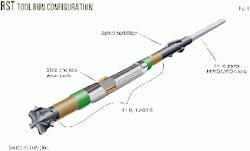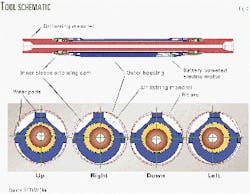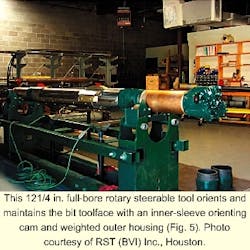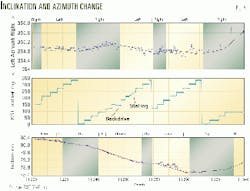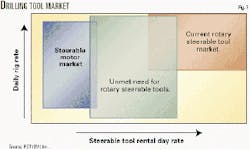Rotary steerable tool design targets increased drilling efficiency, lower running costs
Operating companies continually seek new technologies to drill laterals and extended reach wells further, more efficiently and at lower cost.
Even with higher oil and gas prices, the challenge to develop lower quality and perhaps marginal reserves economically, is a daunting task.
Three-dimensional rotary steerable technologies continue to advance. RST (BVI) Inc. (Rotary Steerable Tools), Houston has patented, designed, and built a rotary steerable system that minimizes complexity and cost while delivering fewer drilling limitations, compared to many tools. The company continues to make progress in bringing this technology to maturity.
The RST tool has a simple design, offering complete three-dimensional directional control during drilling. It is normally run with a slightly under-gauge sleeve or blade-type stabilizer immediately above the tool (Fig. 1).
Major oil companies have tested the 121/4-in. tool to drill just more than 3,660 ft of hole, which includes 281 ft drilled at the Catoosa test facility near Tulsa. The tool has been tested in the Gulf of Mexico to 5,820 ft measured depth.
A major operator also tested the tools in extended reach applications offshore California, to 21,534 ft maximum measured depth, demonstrating effective operation and communication with the tool to that depth. Some of the runs were in the Sisquoc shale, for tangent control in wells targeting Monterey formation reservoirs.
Communication with the tool to command changes in toolface or preprogrammed toolface sequences is performed through drillstring rotation sequences that last 31/2 min each.
Operators benefit from rotary steerable systems, which allow them to rotate the drillstring, rather than just sliding with steerable motors. This gives them faster penetration rates, improved wellbore quality, and reduced tortuosity.
Drill pipe rotation, allowed by rotary steering systems, also improves wellbore hydraulics, lowers static forces on the drillstring, and minimizes the possibility of becoming differentially stuck. Crews can drill extended reach wells and long laterals up to 25% further if they can rotate the drillstring rather than slide it.
Operators have been most interested in rotary steerable system applications for eliminating steerable motors on wells where sliding is next to impossible and drilling progress is extremely slow. These wells primarily are longer reach and more expensive offshore wells.
The benefits of rotary steerable systems can also apply to more-conventional directional wells, to drill smoother wellbores, improve hole cleaning, and drill faster. The challenge, however, is for rotary steerable systems to be cost-effective for these wells.
Tool design
The company had two objectives in mind when it began the design and development process for the RST tool: simplicity and drilling system compatibility.
RST's specific design goals were low manufacturing and operating costs to make more directional wells accessible to rotary steerable technology. Secondly, ease of operation at the rig and complete serviceability in remote locations were important objectives.
The resulting tool is simple in design and combines less than 60 components into a unique package, shown in the tool schematic (Fig. 2). Most rotary steerable systems available today are complex and have between 1,800 and 4,000 components.
Company Pres. Steve McLoughlin said, "Our ideas were less about knowing what we wanted, than knowing things we didn't like. I've run a lot of tools, before the days of rotary steerables. A lot of tools that came out to the field were just not practical.
"I've had to deal with hex keys that were too small. I've been covered in oil-base mud and had electrical connections hanging out. Getting them clean and back inside the tool in that environment just wasn't practical."
Jeff Lasater, executive vice-president for RST's design and engineering group, added, "We didn't have a rule set. That's why, starting from scratch, we ended up with a fairly unique tool."
Remote area operators will benefit from the field repairable design. Once the mandrel connection has been broken-out at the rig floor, the entire tool can be disassembled with full field rebuild in about 12 hr.
Bit force
All rotary steerable systems steer the wellbore during drilling operations by either applying a side force to the bit or by pointing the bit through a shaft or bottom-hole assembly deflection device.
Current systems use either sophisticated directional sensors with feedback circuitry or simple mechanical means, to properly orient the bit side force or maintain the bit-pointing deflection force. The current commercially available rotary steerable systems are configured to operate either in a side-force or point-the-bit mode.
Some operators report that point-the-bit mode has operational and trajectory control advantages over purely side-force rotary steerable systems. Point-the-bit deflection drills a more predictable and smooth wellbore curvature, with less "ledging" and hole washouts.
Point-the-bit devices also allow a wider choice of bit selection since special side-cutting bit designs are not required.
The RST device uses components of both bit side-force and point-the-bit deflection to effect wellbore steering. It does this using an eccentric, inner-sleeve orienting cam, located in the tool a few feet behind the bit.
Rotating the inner-sleeve orienting cam, points the bit and also applies the bit side force in the desired direction of wellbore movement. The new toolface or bit direction is communicated to the RST tool, by selective 31/2 min drillstring-rotation sequences.
The inner-sleeve, cam orientation is maintained by gravity orientation of an outer, mass-weighted housing. This is a simple design, using the gravitational force to orient and maintain "high-side" tool orientation.
The slightly under-gauge sleeve or integral blade stabilizer, run immediately above the RST tool, isolates the weight force of the bottom-hole assembly from the outer housing.
The stabilizer also provides reaming and improved hole cleaning immediately above the RST tool, approximately 14 ft from the bit. This assembly has proven effective for back reaming and washing to bottom.
Drilling personnel can select or change the desired hole curvature characteristics at the rig by selecting the appropriate cam offset. The adjustment, which takes less than 1 hr, is done off of the rig floor.
Engineers select the orienting cam, available in 0, 2.5, 5, 7.5 and 10 mm offsets for the 121/4 in. tool, to provide build or turn rates ranging from 0.3°/100 ft to 7.5°/100 ft. This is similar to selecting the correct bend angle on the bent housing of a steerable motor.
The build or turn rates of the RST tool are in line with maximum build rates attainable using strictly bit side-force rotary steerable tools.
Fig. 3, which shows the top view of the tool in a highly deviated well, illustrates the function of the RST tool. The position of the inner-sleeve orienting cam and the bit arc are shown for both 90° left and 90° right toolface changes.
The components of bit loading from side-force or point-the-bit deflection can vary, depending how the inner-sleeve orienting cams are configured. The tool can be configured as more of a point-the-bit system by placing different cam offsets at either end of the tool.
Conversely, the tool can be configured for more bit side force by using cam offsets at both ends of the tool. Engineers can use other variables to effect tool response, such as changing bit type, stabilizer gauge, stabilizer position, and drill collar rigidity.
Improved hydraulics
Many directional drilling tools, installed just above the bit, whether a steerable motor or rotary steerable, consume up to 600 psi pressure drop. On some rigs this can be as much as 20-30% of the pressure budget.
The RST tool was designed as a full bore system to prevent pressure loss. At 800 gpm of 12 ppg mud, the pressure drop through the tool is about 15 psi, which is essentially the same as a piece of drill collar. Operators considering extended reach wells with smaller rigs may find the pressure savings an enabling issue.
Hole cleaning is another problem where improved hydraulics is important. Operators cannot fully benefit from the higher penetration or drilling rates that rotary steerable systems can achieve if hole cleaning is inadequate due to hydraulic limitations.
Lower pressure drop through the bottom-hole assembly allows the rig to drill more efficiently and effectively. The RST tool imposes no limits to normal drilling practices. Nor does it interfere with the drilling parameter optimization process.
Tool communication
Communication with the tool by rotating the drillstring makes it compatible with any other measurement-while-drilling or logging-while-drilling tools available.
The RST tool may be run stand-alone, requiring only the simplest survey methods to monitor hole position. Alternatively, the tool may be combined with other downhole technologies for an effective high tech, fit-for-purpose system.
Complex instructions can be sent to the RST tool by rotating the drillstring for a 31/2-min interval. This results in changing the toolface to a new setting, to within 2° accuracy. This method of communication with the tool does not interfere with normal drilling operations or require that the driller avoid specific rotary speeds.
The driller can rotate, reciprocate, and circulate while the tool is being programmed. Once the new toolface command is downlinked, the inner-sleeve cam is oriented and locked into position. The rig can then resume drilling. Tangent hole section control is obtained by downlinking to preprogrammed toolface sequences.
The tool electronics are housed in the nonrotating, mass-weighted housing. The electronics assembly is not subject to centrifugal forces during drilling, providing the electronics with a smooth ride.
The electronics record large amounts of diagnostic data, including motor current, battery voltage, and the housing orientation. Once back on surface, this information is downloaded to a laptop computer for analysis.
Weighted housing
Data retrieved from the RST tool following drilling operations in a high angle well indicated good low-side orientation of the weighted outer housing (Fig. 4). The data indicated an average housing roll of about 15°, in the direction of drillstring rotation.
Tests and commercial operations, performed to date, have not defined the lower limit of hole angle at which the weighted, outer housing orientation will remain effective.
Engineers currently think that 40° will provide confident lowside orientation and enable effective toolface control.
The weighted housing can be seen clearly in the photograph in Fig. 5, on the bottom side of the tool.
Extended reach application
A major operating company offshore California contracted the RST tool for several commercial extended reach tests. Past experience in the area revealed that the geology, the Sisquoc shale with dolomite stringers 1-10 ft thick, was very difficult to drill.
The operator's objective was to drill extended reach wells to exploit offset reserves, saving the cost of installing additional infrastructure.
This required drilling extensions into several separate fault blocks, as far as 30,000 ft away from the existing flatform. Extended reach wells had not previously penetrated this shale formation at such a high wellbore angle.
One of the greatest challenges was directional control of a long 121/4-in. tangent interval, which traversed several formations with varying degrees of drillability.
The extended reach wells typically reach the point of "negative weight" about one third of the way into the 121/4-in. tangents, making weight transfer to a steerable motor by sliding the drill pipe extremely difficult, if not impossible.
Faced with the problem of not being able to slide the drill pipe, the operator decided to rotary drill the entire interval. The RST tool was run, to provide three-dimensional trajectory control where necessary.
In one well, the operator ran rotary assemblies, with adjustable gauge stabilizers and specialized bits, and successfully controlled both inclination and azimuth for several thousand feet.
The wellbore drifted right, and the rotary steerable tool was placed in the hole at a toolface position of 60° left of high side.
The tool drilled 125 ft, turning and building the wellbore at 3.1°/100 ft. The RST tool was used to drill a further 493 ft, gathering tool response and diagnostic data, confirming the tool's ability to steer a wellbore in three dimensions.
In another California well, the RST tool was preset to change toolface positions at regular intervals through three complete 360° rotations.
The inclination and azimuth of the well changed as predicted by the toolface setting (Fig. 6). The magnitude of the changing dogleg was proportional to the cam offsets, which were selected prior to running the RST tool in the hole.
Drilling tool market
In mature petroleum basins around the world, many onshore and offshore fields benefit from further infield drilling to recover reserves that otherwise are left behind.
Often operators cannot justify new wells for marginal reserves. Sidetracks or additional and extended reach laterals from existing wells are the only way these reserves can be tapped.
Most rotary steerable tools available today, however, are complex and expensive to build and maintain. Service companies inherently require high day rates in order to make the tools financially feasible, which forces the technology into a niche market of the most difficult and complex wells.
Fig. 7 depicts the idea graphically, making a relative comparison between rig rate and steering tool rental cost, with the current niche market indicated in the upper right portion of the graph.
Anecdotally, only about 15% of the rigs in the North Sea can afford to run rotary steerable systems, limiting rotary steerable technology to only the more-expensive wells.
Normal directional wells can benefit from rotary steerable technology if the economics become favorable.
Acknowledgments
The author thanks S. McLoughlin, president, RST; G. Sutherland, executive vice-president, RST; and J. Lasater, executive vice-president, RST for their help in this article.
Bibliography
Sutherland, G., McLoughlin, S., Chance, J., and Variava, F., "Development and Application of Versatile and Economical 3D Rotary Steering Technology," AADE Paper 01-NC-HO-21, 2001 AADE National Drilling Conference, Mar. 27-29, 2001, Houston.
McMillin, K., "Rotary steerable technology extends well in difficult geology," Offshore, December 1999.
